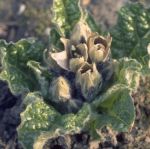| Common Name: |
Alraunwurzel |
| Other Names: |
Mandragora, Mandrake, Satan's Apple |
| Botanical Name: |
Mandragora officinarum |
| Genus: |
Mandragora |
| Family: |
Solanaceae |
| Native Locations: |
N Italy, W Balkans, Greece, and W Turkey |
| Cultivation: |
Deep, light, well-drained soil, around pH7, in a sunny, sheltered position. Resents root disturbances. Dislikes cold, wet conditions in winter. Prone to damage by slugs and snails. |
| Propagation: |
By seed sown when ripe; by root cuttings in winter. |
| Harvest: |
Roots are collected during dormancy and grated fresh for extraction of juice, or dried for use in decoctions. |
| Height: |
30cm (12in) |
| Width: |
60cm (24in) |
| Hardiness: |
Z6-8 |
| Warning: |
Toxic if eaten.
This herb is subject to legal restrictions in some countries. |
| Parts Used: |
Roots, Whole Plant |
| Properties: |
A sedative, painkilling herb that has purgative and emetic effects. |
| Medicinal Uses: |
Internally, used formerly as a painkiller, aphrodisiac, and treatment for nervous disorder. Externally for ulcers, and rheumatic or arthritic pain. For use by qualified practitioners.
To treat stomach ulcers, hay fever, whooping cough, and asthma. |
| Possible Side Effects: |
Mandrake's side effects include drowsiness, confusion, dry mouth, blurred vision, decreased sweating, overheating, and flushing. |
| Drug Interactions: |
| Taking mandrake with these drugs may increase the therapeutic and/or adverse effects of the drug: |
| Atropine, (Isopto Atropine, Sal-Tropine) |
Benztropine, (Apo-Benztropine, Cogentin) |
Clidinium and Chlordiazepoxide, (Apo-Chlorax, Librax) |
Cyclopentolate, (Cyclogyl, Cylate) |
| Dicyclomine, (Bentyl, Lomine) |
Glycopyrrolate, (Robinul, Robinul Forte) |
Homatropine, (Isopto Homatropine) |
Hyoscyamine, (Hyosine, Levsin) |
| Hyoscyamine, Atropine, Scopolamine, and Phenobarbital, (Donnatal, Donnatal Extentabs) |
Ipratropium, (Atrovent, Nu-Ipratropium) |
Oxitropium, (Oxivent, Tersigat) |
Prifinium, (Padrin, Riabel) |
| Procyclidine, (Kemadrin, Procyclid) |
Propantheline, (Propanthel) |
Scopolamine, (Scopace, Transderm Scop) |
Tiotropium, (Spiriva) |
| Tolterodine, (Detrol, Detrol LA) |
Trihexyphenidyl, (Apo-Trihex) |
Trimethobenzamide, (Tigan) |
|
| Disease Effects: |
May worsen coronary artery disease, rapid heart rate, congestive heart failure, elevated blood pressure, stomach ulcers, gastrointestinal ailments, gastroesophageal reflux disease (GERD), narrow-angle glaucoma, benign prostatic hypertrophy (BPH), liver disease, or kidney disease. |
| Supplement Interactions: |
May increase positive and negative effects of herbs and supplements that have anticholinergic effects, such as Belladonna, Henbane, and Scopolia. |
| Bibliography: |
Encyclopedia of Herbs by Deni Brown Copyright © 1995, 2001 Dorling Kindersley Limited. pg 271
The Essential Herb-Drug-Vitamin Interaction Guide by Geo. T. Grossberg,MD and Barry Fox,PhD Copyright©2007 Barry Fox,PhD. Pp.328-329 |

